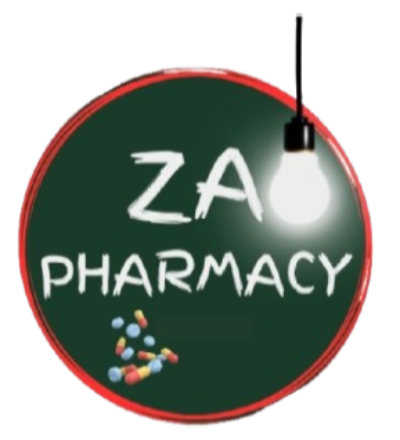Za Pharmacy
Drugs, Supplies and Delivery
Augmentin
Augmentin is a widely prescribed antibiotic medication used to treat a variety of bacterial infections. It is a combination drug containing two active ingredients: amoxicillin (a penicillin-class antibiotic) and clavulanic acid (a beta-lactamase inhibitor). This article provides a detailed overview of Augmentin, referencing authoritative sources such as the British National Formulary (BNF), Lippincott Textbook of Pharmacology, and Lange Basic & Clinical Pharmacology. We will explore its mechanism of action, uses, dosage, side effects, precautions, drug interactions, and generic names in pharmacy
Amoxicillin
Amoxicillin, a beta-lactam antibiotic, works by inhibiting the synthesis of bacterial cell walls. According to the Lippincott Textbook of Pharmacology, amoxicillin binds to penicillin-binding proteins (PBPs) located inside the bacterial cell wall. This binding disrupts the final stages of peptidoglycan synthesis, a critical component of the cell wall. As a result, the bacterial cell wall becomes weak and prone to rupture, leading to cell death.
Clavulanic Acid
Clavulanic acid, as described in the Lange Basic & Clinical Pharmacology, is a beta-lactamase inhibitor. Beta-lactamases are enzymes produced by some bacteria that break down the beta-lactam ring of antibiotics like amoxicillin, rendering them ineffective. Clavulanic acid binds irreversibly to these enzymes, preventing them from degrading amoxicillin. This action extends the spectrum of amoxicillin to include beta-lactamase-producing bacteria.
Augmentin is indicated for the treatment of various bacterial infections, including:
- Respiratory Tract Infections: Such as sinusitis, bronchitis, and pneumonia.
- Ear, Nose, and Throat (ENT) Infections: Including otitis media and tonsillitis.
- Urinary Tract Infections (UTIs): Such as cystitis and pyelonephritis.
- Skin and Soft Tissue Infections: Including cellulitis and wound infections.
- Dental Infections: Such as abscesses and periodontal infections.
- Bone and Joint Infections: Including osteomyelitis.
The British National Formulary (BNF) emphasizes that Augmentin should only be used for bacterial infections and is ineffective against viral infections like the common cold or flu.
The dosage of Augmentin varies depending on the type and severity of the infection, the patient's age, weight, and renal function. The following are general guidelines:
Adults and Children (≥40 kg)
- Standard Dose: 500 mg amoxicillin/125 mg clavulanic acid (one tablet) every 8 hours or 875 mg/125 mg every 12 hours.
- Severe Infections: 875 mg/125 mg every 8 hours.
Children (<40 kg)
- Dosage is based on body weight, typically 25-45 mg/kg/day of the amoxicillin component, divided into two or three doses.
Renal Impairment
- Dose adjustments are necessary for patients with impaired kidney function. Consult the BNF for specific recommendations.
Augmentin is available in various formulations, including tablets, chewable tablets, and oral suspensions. It should be taken with food to enhance absorption and reduce gastrointestinal side effects.
Augmentin is generally well-tolerated, but like all medications, it may cause side effects. Common side effects, as listed in the Lippincott Textbook of Pharmacology, include:
- Gastrointestinal Issues: Nausea, vomiting, diarrhea, and abdominal pain.
- Skin Reactions: Rash, itching, and urticaria (hives).
- Oral Thrush or Vaginal Candidiasis: Due to disruption of normal flora.
Less common but serious side effects may include:
- Hepatotoxicity: Liver dysfunction, indicated by jaundice or elevated liver enzymes.
- Allergic Reactions: Such as angioedema, anaphylaxis, or Stevens-Johnson syndrome.
- Blood Disorders: Including leukopenia, thrombocytopenia, or hemolytic anemia.
Patients experiencing severe side effects should seek medical attention immediately.
Before starting Augmentin, certain precautions should be taken:
- Allergy to Penicillins or Cephalosporins: Augmentin is contraindicated in patients with a history of hypersensitivity to beta-lactam antibiotics.
- Liver Disease: Use with caution in patients with hepatic impairment, as clavulanic acid may increase the risk of hepatotoxicity.
- Renal Impairment: Dose adjustments are necessary for patients with reduced kidney function.
- Pregnancy and Breastfeeding: Augmentin is generally considered safe during pregnancy and breastfeeding, but should only be used if clearly needed and under medical supervision.
- Monitoring: Regular monitoring of liver and kidney function is recommended during prolonged therapy.
Augmentin may interact with other medications, potentially altering their effects or increasing the risk of side effects. Key interactions highlighted in the BNF and Lange Basic & Clinical Pharmacology include:
- Probenecid: May increase amoxicillin levels by reducing its renal excretion.
- Oral Contraceptives: Augmentin may reduce the efficacy of hormonal contraceptives, necessitating additional contraceptive measures.
- Methotrexate: Augmentin may increase methotrexate levels, increasing the risk of toxicity.
- Warfarin: Augmentin may enhance the anticoagulant effect of warfarin, increasing the risk of bleeding.
- Allopurinol: Concurrent use may increase the risk of skin rashes.
Always inform your healthcare provider about all medications, supplements, and herbal products you are taking before starting Augmentin.
Augmentin is the brand name for the combination of amoxicillin and clavulanic acid. In pharmacies, it may also be available under various generic names, including:
- Co-amoxiclav (commonly used in the UK and other countries)
- Amoxicillin/Clavulanate Potassium
- Amoclan
- Clavam

